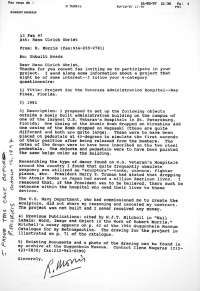13 Feb 97
Att: Hans Ulrich Obrist
From: R. Morris (fax:914-255-2781)
Re: Unbuilt Roads
Dear Hans Ulrich Obrist, Thanks for you recent fax inviting me to participate in your project. I send along some information about a project that might be of some interest--I follow your 6-category questionnaire:
Title:
Project tor the Veterans Administration Hospital--Bay Pines, Florida.
Year:
1981
Description:
I proposed to set up the following objects outside a newly built administration building on the campus of one of the largest U.S. Veteran's Hospitals in st. Petersburg, Florida: one casing of the Atomic Bomb dropped on Hiroshima and one casing of the Bomb dropped on Nagasaki (these are quite different and both are quite larqe). These were to have been placed on pedestals at 45-degrees to simulate the first seconds of their position after being released from the bombers. The dates of the drops were to have been inscribed on the two steel pedestals. The objects and pedestals were to have been painted the same beige color as the building.
Researching the type of decor found on U.S. Veteran's Hospitals around the country I found that quite frequently obsolete weaponry was utilized as "sculpture"--tanks, cannons, fighter planes, etc. President Harry s. Truman had stated that dropping the Atomic Bombs on Japan had saved a million American lives. I reasoned that, if the President was to be believed, there must be veterans within the hospital who owed their lives to these devices.
The U.S. Navy Department, who had commissioned me to create the sculpture, did not share my reasoning and canceled my contract. The project was not built and I never received any money.
Previous Publications:
cited by W.J.T. Mitchell in "Wall Labels: Word, Image and Object in the Work of Robert Morris."
Mitchell's essay appears on p.62 of the 1994 Guggenheim Museum Catalogue for my Retrospective. The drawing for the project is illustrated on p.71 of the catalogue.Exisiting Documents and a photo of a the drawing can be found in my archive at the Guggenhiem Museum. Contact Ilene Magaras (212-423-3830; fax: 212-941-0590)
Sincerely,
R. Morris
13 Feb 97
Att: Hans Ulrich Obrist
From: R. Morris (fax:914-255-2781)
Re: Unbuilt Roads
Dear Hans Ulrich Obrist, Thanks for you recent fax inviting me to participate in your project. I send along some information about a project that might be of some interest--I follow your 6-category questionnaire:
Title:
Project tor the Veterans Administration Hospital--Bay Pines, Florida.
Year:
1981
Description:
I proposed to set up the following objects outside a newly built administration building on the campus of one of the largest U.S. Veteran's Hospitals in st. Petersburg, Florida: one casing of the Atomic Bomb dropped on Hiroshima and one casing of the Bomb dropped on Nagasaki (these are quite different and both are quite larqe). These were to have been placed on pedestals at 45-degrees to simulate the first seconds of their position after being released from the bombers. The dates of the drops were to have been inscribed on the two steel pedestals. The objects and pedestals were to have been painted the same beige color as the building.
Researching the type of decor found on U.S. Veteran's Hospitals around the country I found that quite frequently obsolete weaponry was utilized as "sculpture"--tanks, cannons, fighter planes, etc. President Harry s. Truman had stated that dropping the Atomic Bombs on Japan had saved a million American lives. I reasoned that, if the President was to be believed, there must be veterans within the hospital who owed their lives to these devices.
The U.S. Navy Department, who had commissioned me to create the sculpture, did not share my reasoning and canceled my contract. The project was not built and I never received any money.
Previous Publications:
cited by W.J.T. Mitchell in "Wall Labels: Word, Image and Object in the Work of Robert Morris."
Mitchell's essay appears on p.62 of the 1994 Guggenheim Museum Catalogue for my Retrospective. The drawing for the project is illustrated on p.71 of the catalogue.Exisiting Documents and a photo of a the drawing can be found in my archive at the Guggenhiem Museum. Contact Ilene Magaras (212-423-3830; fax: 212-941-0590)
Sincerely,
R. Morris

